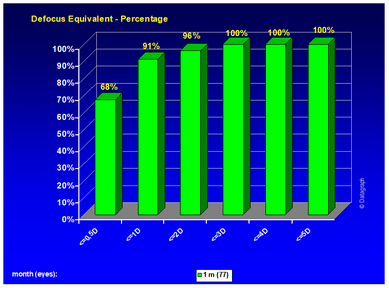
Defocus equivalent is a measure of residual refractive error following refractive procedures and is important for the analysis of mixed astigmatism cases, where just looking at postoperative spherical equivalent can be misleading.
Example: A patient with -1/+2 @ 90° may be extremely unhappy, but would show up as perfectly zero in a spherical equivalent (SEQ) graph (sph + 1/2 cyl; respecting the sign).
In a defocus equivalent (DEQ) graph, we calculate: |SEQ| + |1/2 cyl| (ignoring the sign). The result in this case would be +1 D, which better reflects the reality of the refractive state of this eye.
The defocus equivalent was first defined by Holladay et.al. in 1991 (Holladay JT, Lynn MJ, Waring GO, Gemmill M, Keehn CG, Fielding B. The relationship of visual acuity, refractive error, and pupil size after radial keratotomy. Arch Ophthalmol 1991;109:70-76) to eliminate the inequity between eyes that had similar sphero-equivalent refractions but different amounts of astigmatism. The defocus equivalent is proportional to the area of the blur circle of the conoid of Sturm.